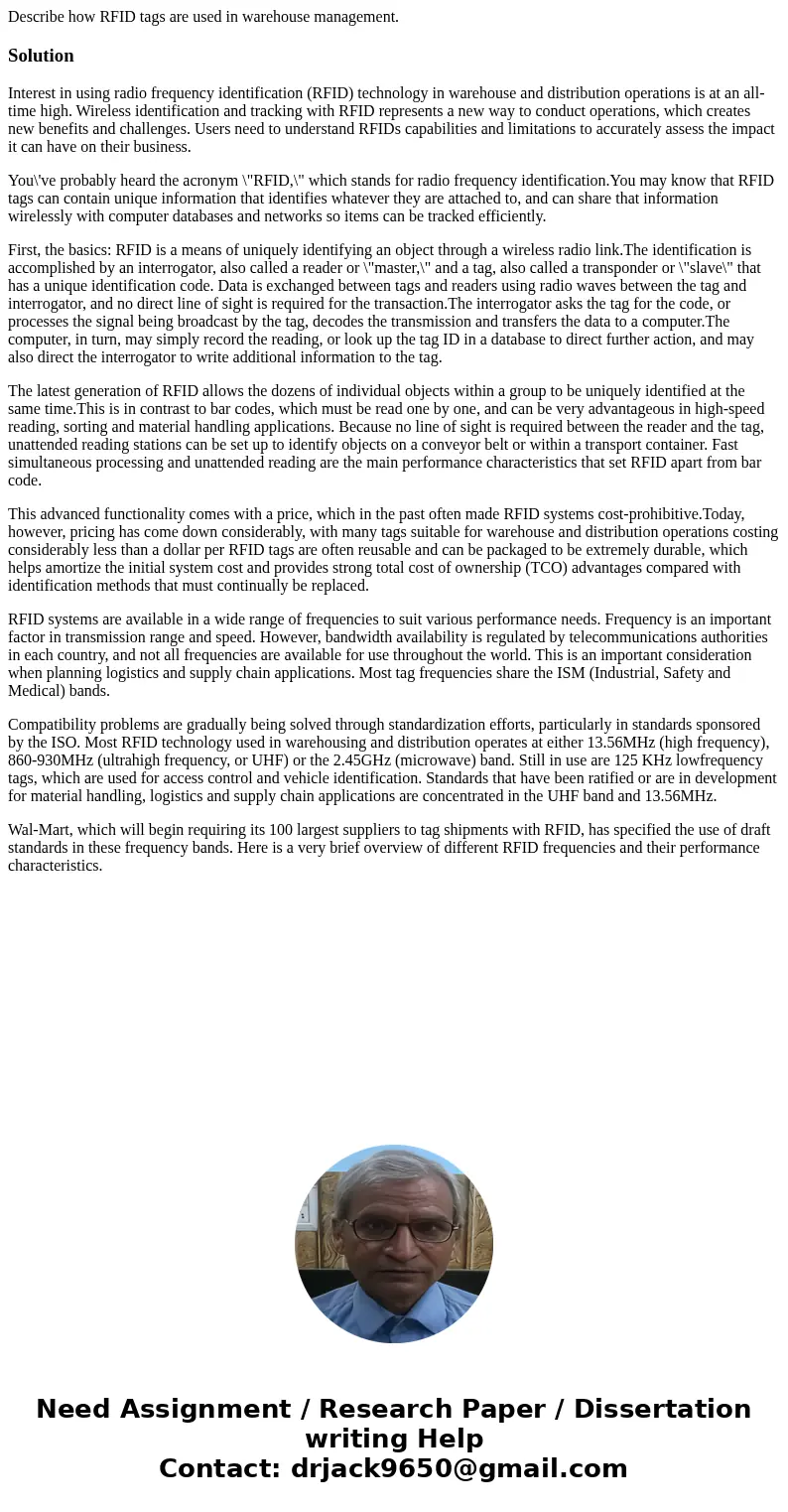Describe how RFID tags are used in warehouse managementSolut
Describe how RFID tags are used in warehouse management.
Solution
Interest in using radio frequency identification (RFID) technology in warehouse and distribution operations is at an all-time high. Wireless identification and tracking with RFID represents a new way to conduct operations, which creates new benefits and challenges. Users need to understand RFIDs capabilities and limitations to accurately assess the impact it can have on their business.
You\'ve probably heard the acronym \"RFID,\" which stands for radio frequency identification.You may know that RFID tags can contain unique information that identifies whatever they are attached to, and can share that information wirelessly with computer databases and networks so items can be tracked efficiently.
First, the basics: RFID is a means of uniquely identifying an object through a wireless radio link.The identification is accomplished by an interrogator, also called a reader or \"master,\" and a tag, also called a transponder or \"slave\" that has a unique identification code. Data is exchanged between tags and readers using radio waves between the tag and interrogator, and no direct line of sight is required for the transaction.The interrogator asks the tag for the code, or processes the signal being broadcast by the tag, decodes the transmission and transfers the data to a computer.The computer, in turn, may simply record the reading, or look up the tag ID in a database to direct further action, and may also direct the interrogator to write additional information to the tag.
The latest generation of RFID allows the dozens of individual objects within a group to be uniquely identified at the same time.This is in contrast to bar codes, which must be read one by one, and can be very advantageous in high-speed reading, sorting and material handling applications. Because no line of sight is required between the reader and the tag, unattended reading stations can be set up to identify objects on a conveyor belt or within a transport container. Fast simultaneous processing and unattended reading are the main performance characteristics that set RFID apart from bar code.
This advanced functionality comes with a price, which in the past often made RFID systems cost-prohibitive.Today, however, pricing has come down considerably, with many tags suitable for warehouse and distribution operations costing considerably less than a dollar per RFID tags are often reusable and can be packaged to be extremely durable, which helps amortize the initial system cost and provides strong total cost of ownership (TCO) advantages compared with identification methods that must continually be replaced.
RFID systems are available in a wide range of frequencies to suit various performance needs. Frequency is an important factor in transmission range and speed. However, bandwidth availability is regulated by telecommunications authorities in each country, and not all frequencies are available for use throughout the world. This is an important consideration when planning logistics and supply chain applications. Most tag frequencies share the ISM (Industrial, Safety and Medical) bands.
Compatibility problems are gradually being solved through standardization efforts, particularly in standards sponsored by the ISO. Most RFID technology used in warehousing and distribution operates at either 13.56MHz (high frequency), 860-930MHz (ultrahigh frequency, or UHF) or the 2.45GHz (microwave) band. Still in use are 125 KHz lowfrequency tags, which are used for access control and vehicle identification. Standards that have been ratified or are in development for material handling, logistics and supply chain applications are concentrated in the UHF band and 13.56MHz.
Wal-Mart, which will begin requiring its 100 largest suppliers to tag shipments with RFID, has specified the use of draft standards in these frequency bands. Here is a very brief overview of different RFID frequencies and their performance characteristics.

 Homework Sourse
Homework Sourse